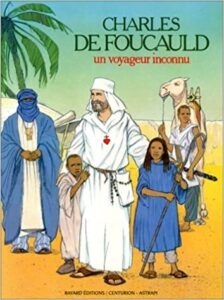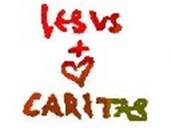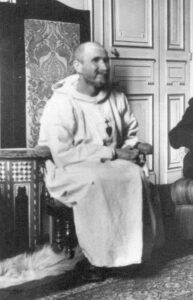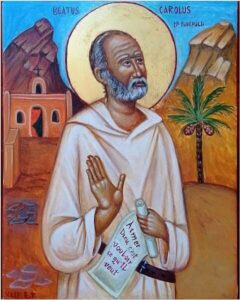A large family
international Association
The origins
 At the death of Charles de Foucauld in Tamanrasset, on December 1, 1016, there are 49 registered, -one of them Charles himself- in the list of members of the Union of Brothers and Sisters of the Sacred Heart of Jesus, in what he worked to get it up and running in the last years of his life, and for which he wrote the Directory. “And everything was destroyed at his death,” writes Fr. Laurain, secretary of the Union, and everyone thinks that the group is going to die out as soon as it started. All except one, Luis Massignon, an Islamologist who will achieve world fame. He met Charles de Foucauld for the first time in 1909, and corresponded with him until his death. He does everything he can to keep alive the Union so dear to his “older brother”. And he launches the Charles de Foucauld Association, for which he obtains the authorization of Cardinal Amette. And, above all, he “requisitioned”, in his own words, the novelist René Bazin to write a biography of bro. carlos This book, published in 1921 under the title of Charles de Foucauld, explorateur au Maroc, hermitage au Sahara, is the first to draw the portrait and to present the essential message of P. de Foucauld. It is from this biography that groups and congregations will emerge. Everyone will find support and advice in the Association and in Massignon. Massignon will distance himself little by little from the Association, but until his death he will continue to animate a group of men and women, laity, religious, and priests, who are inspired by spirituality of the Directory. In 1947 he gives the group the name of Sodality of the Directory. This group of origins is today called Union-Sodality and has members on all continents.
At the death of Charles de Foucauld in Tamanrasset, on December 1, 1016, there are 49 registered, -one of them Charles himself- in the list of members of the Union of Brothers and Sisters of the Sacred Heart of Jesus, in what he worked to get it up and running in the last years of his life, and for which he wrote the Directory. “And everything was destroyed at his death,” writes Fr. Laurain, secretary of the Union, and everyone thinks that the group is going to die out as soon as it started. All except one, Luis Massignon, an Islamologist who will achieve world fame. He met Charles de Foucauld for the first time in 1909, and corresponded with him until his death. He does everything he can to keep alive the Union so dear to his “older brother”. And he launches the Charles de Foucauld Association, for which he obtains the authorization of Cardinal Amette. And, above all, he “requisitioned”, in his own words, the novelist René Bazin to write a biography of bro. carlos This book, published in 1921 under the title of Charles de Foucauld, explorateur au Maroc, hermitage au Sahara, is the first to draw the portrait and to present the essential message of P. de Foucauld. It is from this biography that groups and congregations will emerge. Everyone will find support and advice in the Association and in Massignon. Massignon will distance himself little by little from the Association, but until his death he will continue to animate a group of men and women, laity, religious, and priests, who are inspired by spirituality of the Directory. In 1947 he gives the group the name of Sodality of the Directory. This group of origins is today called Union-Sodality and has members on all continents.
The first groups
When René Bazin’s book appears, the laity are the first to hear the call that bro. Carlos had done several times: «Christians like Priscilla and Aquila would be needed, who would do good in silence».
As early as 1923, Suzanne Garde began to think of a presence in North Africa: «Evangelization would be carried out by women. Starting with a dispensary, a workshop, with everything that could make us friendly to the Arabs». The Charles de Foucauld Group thus began in Algeria, first in Tlemcen and then in El-Bayad, and from 1945 in Dalida, near the border with Tunisia. When the war of independence arrived, she withdrew to France, and in 1968 she settled in Bon Encontre, near Agen. Around the same time, the group of Infirmières de Notre Dame de Cartaghe (Nurses of Our Lady of Carthage) was born in Tunisia. under the impulse of the Bishop of Carthage and Tunis. The same bishop had given in 1924 “the habit of Charles de Foucauld” to Charles Henrion and Émile Malcor. The last members of the group of nurses will have to withdraw to France in 1961 (with Fr. Henrion), and will consolidate in Villecroze, in the Var. Currently a sister lives in a nursing home, but the group as such no longer exists. Still in the same period, in 1927 Fr. Albert Peyriguère settles in Morocco (he had first tried to live in  Algeria with a companion, following the Rule written by Charles de Foucauld in 1899). There he will remain in the Moroccan Middle Atlas, until his death in 1959; Fr. Michel Lafon will continue this presence of a “missionary monk”, according to C. de Foucauld’s expression that Fr. Peyriguère had made his own. Some years later the first religious communities appeared. In August 1933, around Sr. Marie-Charles was born the fraternity of Little Sisters of the Sacred Heart, near Montpellier. A month later, Rene Voillaume and four other brothers took the habit of the Little Brothers of Jesus, and founded their first fraternity in Algeria. In 1939, in Algiers, they pronounce their vows as Little Sisters of Jesus the Sister. Magdeleine and a companion, and became strong in Touggourt, among the nomads. With different nuances, the three groups want to be contemplative and missionary communities. The Little Brothers of Jesus and the Little Sisters of the Sacred Heart will first live in a rather “monastic” way; The years that followed the Second World War, for the former, and the Second Vatican Council, for the latter, will bring about a change in lifestyle and the constitution of small fraternities in popular environments, as the Little Sisters of Jesus already lived. The key word is “Nazareth” as a form of religious life: to seek the face of God, to follow the path that Jesus followed, that of sharing ordinary life on a daily basis. Fraternities were founded in the four winds of the planet, in disadvantaged or degraded environments. We must also mention, although the group no longer exists, the Union des Nazaréennes de Charles de Foucauld (Union of Nazarene Sisters of C. de Foucauld), founded in 1947 by Magdalena de Vimont, in Bordeaux. She was struck by the reading of the Directory and by the contact with the mentally ill, to whom the group was first dedicated.
Algeria with a companion, following the Rule written by Charles de Foucauld in 1899). There he will remain in the Moroccan Middle Atlas, until his death in 1959; Fr. Michel Lafon will continue this presence of a “missionary monk”, according to C. de Foucauld’s expression that Fr. Peyriguère had made his own. Some years later the first religious communities appeared. In August 1933, around Sr. Marie-Charles was born the fraternity of Little Sisters of the Sacred Heart, near Montpellier. A month later, Rene Voillaume and four other brothers took the habit of the Little Brothers of Jesus, and founded their first fraternity in Algeria. In 1939, in Algiers, they pronounce their vows as Little Sisters of Jesus the Sister. Magdeleine and a companion, and became strong in Touggourt, among the nomads. With different nuances, the three groups want to be contemplative and missionary communities. The Little Brothers of Jesus and the Little Sisters of the Sacred Heart will first live in a rather “monastic” way; The years that followed the Second World War, for the former, and the Second Vatican Council, for the latter, will bring about a change in lifestyle and the constitution of small fraternities in popular environments, as the Little Sisters of Jesus already lived. The key word is “Nazareth” as a form of religious life: to seek the face of God, to follow the path that Jesus followed, that of sharing ordinary life on a daily basis. Fraternities were founded in the four winds of the planet, in disadvantaged or degraded environments. We must also mention, although the group no longer exists, the Union des Nazaréennes de Charles de Foucauld (Union of Nazarene Sisters of C. de Foucauld), founded in 1947 by Magdalena de Vimont, in Bordeaux. She was struck by the reading of the Directory and by the contact with the mentally ill, to whom the group was first dedicated.
Publication of “In the heart of the masses”, and new initiatives
In 1950 Fr. Voillaume published In the heart of the masses. This book presents the way of life of the Little Brothers of Jesus and their way of following Fr. de Foucauld and understanding his message. And because it seems necessary to explain what appears to be new at that moment, he insists on the vocation of every Christian to a life of friendship with God and on the paths to take for a “contemplative” life in the heart of the world. The influence of this book will be considerable and will become many languages; through him many will know C. de Foucauld and his spirituality. Fr. Voillaume will help with his advice to the groups that appear in this period.
Also in 1950 Msgr. de Provenchères, bishop of Aix-en-Provence, officially recognized the Charles de Foucauld Secular Fraternity (at first called “Charles de Foucauld Fraternity”). But in fact, many years before, in various cities of France, groups of Christians (men and women, single and married, laity and priests) had acquired the habit of meeting regularly to help each other follow Jesus and live the Gospel in the spirit of C. de Foucauld. The Secular Fraternity is today very much alive on all the continents, and new groups are born every year. It is the largest  group of the “Family”. Within this group, some priests got used to meeting apart with the desire to give their life and their priestly ministry the evangelical style of C. de Foucauld. This is how the Priestly Union was born in 1951, which in 1976 will take the name of Iesus Caritas Priestly Fraternity. Today it is present on all continents. During the same years, some young Christians felt the call to a contemplative life lived in celibacy, bound by vows, keeping their socio-professional commitments and without adopting the form of a religious life in community. Thus, in 1952, around Margarita Poncet, the Iesus Caritas Fraternity was born, which will be officially recognized as a female Secular Institute. In 1991, the Charles de Foucauld Fraternity was born from this group, an association of lay women committed to celibacy. Based on the experience of the Little Brothers of Jesus, Fr. Voillaume thought of communities that could be responsible for spreading the Good News among the most disadvantaged populations and concerns for their human promotion. And he founded in 1956 the Little Brothers of the Gospel, and then, in 1963, the Little Sisters of the Gospel.
group of the “Family”. Within this group, some priests got used to meeting apart with the desire to give their life and their priestly ministry the evangelical style of C. de Foucauld. This is how the Priestly Union was born in 1951, which in 1976 will take the name of Iesus Caritas Priestly Fraternity. Today it is present on all continents. During the same years, some young Christians felt the call to a contemplative life lived in celibacy, bound by vows, keeping their socio-professional commitments and without adopting the form of a religious life in community. Thus, in 1952, around Margarita Poncet, the Iesus Caritas Fraternity was born, which will be officially recognized as a female Secular Institute. In 1991, the Charles de Foucauld Fraternity was born from this group, an association of lay women committed to celibacy. Based on the experience of the Little Brothers of Jesus, Fr. Voillaume thought of communities that could be responsible for spreading the Good News among the most disadvantaged populations and concerns for their human promotion. And he founded in 1956 the Little Brothers of the Gospel, and then, in 1963, the Little Sisters of the Gospel.
The Beni-Abbés meeting of 1955 and the Association
Given this flourishing of groups linked to Fr. de Foucauld, there is a need for a “meeting that concretizes fraternal unity while respecting the different vocations, in common fidelity to the message left by Brother Carlos” (little sister Magdalena) . On the other hand, in the context of decolonization, some groups, especially in France, try to make Charles de Foucauld the defender of “Christian civilization” against the march towards independence of the peoples of the Maghreb. There is also a desire to create a representative Association that can respond and explain that the message of the “universal brother” should not be distorted to be used for purposes contrary to its intentions. Thus, a meeting is organized in Beni-Abbés, from 14 to November 16, 1955. Around Msgr. Mercier, Bishop of the Sahara, host of the meeting, and Luis Massignon, participant Msgr. de Provenchères, Bishop of Aix-en-Provence, friend and protector of the various groups from the beginning ,Mons. Duperray, Bishop of Montpellier, Fr. Peyriguère and representatives – many of them founders – of the different groups existing at the time. Prayer and sharing mark this encounter-pilgrimage. There, the creation of the Charles de Jesús-Père de Foucauld Association was decided. Its objective: “to express the unity of spirituality that encourages the different groups that want to be followers of the religious thought and spirituality of Brother Charles; make known the figure and the writings of its founder; defend, if necessary, his memory and the meaning of his message against the distortions to which they are exposed”. It is also decided that the Iesus Caritas bulletin will be the link between all the groups, expressing their common spirituality. . The association is today called the Charles de Foucauld Spiritual Family Association (“Association Famille Spirituelle Charles de Foucauld”). Normally, it is open to receive new members. It is not an essential characteristic, but it is interesting to note that all these new groups have been born outside France, first in Europe, and then in other continents.
The “family” continues to grow
 August 15, 1966 is the official birth date of the Little Sisters of Nazareth, in Ghent (Belgium). It is a group of young people, committed to the world of workers in the YCW, who want to be inspired at the same time by the message of C. de Foucauld and that of Cardinal Cardijn: to find a form of religious life marked by sharing life of the popular media, and announce, with their way of living and acting, to everyone they meet, that “your life is worth more than all the gold in the world”.
August 15, 1966 is the official birth date of the Little Sisters of Nazareth, in Ghent (Belgium). It is a group of young people, committed to the world of workers in the YCW, who want to be inspired at the same time by the message of C. de Foucauld and that of Cardinal Cardijn: to find a form of religious life marked by sharing life of the popular media, and announce, with their way of living and acting, to everyone they meet, that “your life is worth more than all the gold in the world”.
Also at the beginning of the 1960s, in Catalonia (Spain), Pere Vilaplana was impressed by the reading of Carlos de Foucauld’s Spiritual Itinerary (by J.-F. Six) and by the letters of P. Peyriguère. Around him a community of young people was formed who consecrated themselves to the Lord in marriage – each home constituted a fraternity – or in a life of celibacy lived in small fraternities. The first commitments were made in 1968, establishing the Community of Jesus. In 1969, in the diocese of Foligno (Italy), the bishop recognized a small community that had emerged in his diocese, the Comunità dei Piccoli Fratelli di Jesús Caritas, founded by Giancarlo Sibilia . They are priests who want to live in a monastic community with a strong fraternal life, exercising their pastoral ministry for the dioceses. Thousands of kilometers away, in Haiti, the Little Brothers and Sisters of the Incarnation were born (the first in 1976; the second in 1985), around Francklin Armand and Emmanuelle Victor. In that country, marked by poverty and all sorts of difficulties, they want to become “peasants with the peasants because of Jesus and his Gospel”, and work to promote and evangelize the rural world. In the diocese of Bangui, in the In the Central African Republic, a female religious community, the Little Sisters of the Heart of Jesus, started in 1977. In one of the poorest countries on the planet, shaken by political unrest for years, a fraternal presence, dedicated to prayer, welcoming to everyone, putting itself at the service of the people, it constitutes a very welcome space for peace. In 1980 a monastic community, the Little Brothers of the Cross, founded by Fr. Michel Verret (Br. Michel Marie de la Croix) was constituted in Canada. Following C. de Foucauld, they want to live within the framework of the monastery a fraternal “family” life, open to the welcome and accompaniment of any person who comes. .The last group received in the family is a group founded in Vietnam in the early 1980s, with a view to becoming a secular institute. The Vietnamese name whose initials are AEPS, stands for Brothers and Sisters for Service. The group has a male and a female branch, as well as an associate branch. There is the great family of a man who died alone! And the family of those who find Carlos de Foucauld an inspiration for their lives does not end with the list of members of the Association! There are other groups, which are often integrated into the “Family” at the local level. There are groups that have disappeared, others that are being formed. And many people who are not part of any organization, adopt in C. de Foucauld someone animated by a breath of Gospel and humanity, who also reaches them and gets them started. As for the Association, it currently meets in Assembly every two years. It is an occasion for those responsible for the different groups to meet and communicate. Between assemblies, there is a team chosen by the Assembly, which is in charge of coordination. For many years, while they lived in this world, Mons. de Provenchères, Fr. Voillaume or Sr. Magdeleine strongly marked these meetings and the life of the Association. Currently they meet with those responsible, who succeed each other according to the rules, they maintain these regularly; they try to delve together into the message of bro. Carlos and to discover the richness and variety of responses presented by each group. They know that they are different, but animated by a common spirit, like the rainbow, which needs all the colors to reach its splendor.
PDF: Spiritual Family Charles de FOUCAULD in the word. Brief history



